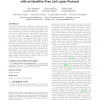112 search results - page 22 / 23 » Securely Obfuscating Re-encryption |
CCS
2010
ACM
13 years 6 months ago
2010
ACM
In this work we present a characterization of spam on Twitter. We find that 8% of 25 million URLs posted to the site point to phishing, malware, and scams listed on popular blackl...
MOBISYS
2007
ACM
14 years 5 months ago
2007
ACM
The broadcast and tetherless nature of wireless networks and the widespread deployment of Wi-Fi hotspots makes it easy to remotely locate a user by observing her wireless signals....
WWW
2010
ACM
14 years 23 days ago
2010
ACM
JavaScript is a browser scripting language that allows developers to create sophisticated client-side interfaces for web applications. However, JavaScript code is also used to car...
ACSAC
2009
IEEE
14 years 18 days ago
2009
IEEE
—Along with the burst of open source projects, software theft (or plagiarism) has become a very serious threat to the healthiness of software industry. Software birthmark, which ...
MOBISYS
2008
ACM
14 years 5 months ago
2008
ACM
We present the design and evaluation of an 802.11-like wireless link layer protocol that obfuscates all transmitted bits to increase privacy. This includes explicit identifiers su...

